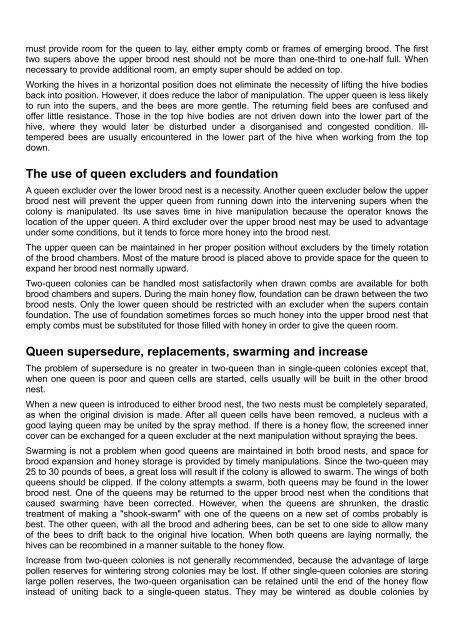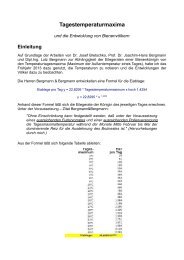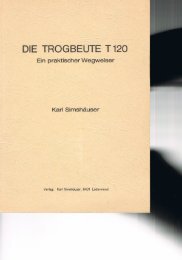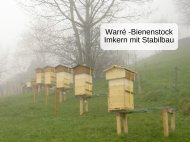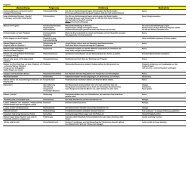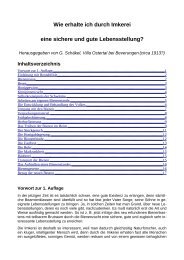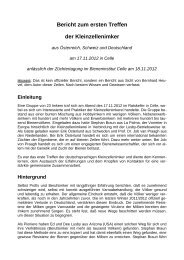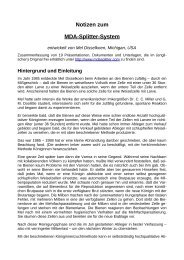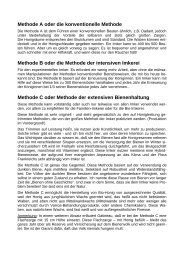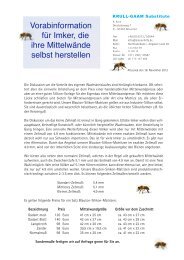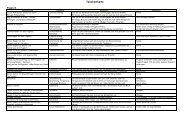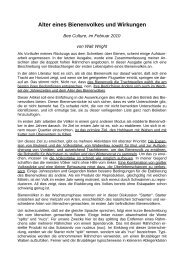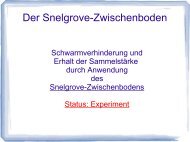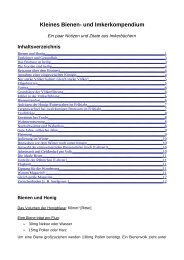Two-queen colony management - Immenfreunde
Two-queen colony management - Immenfreunde
Two-queen colony management - Immenfreunde
You also want an ePaper? Increase the reach of your titles
YUMPU automatically turns print PDFs into web optimized ePapers that Google loves.
must provide room for the <strong>queen</strong> to lay, either empty comb or frames of emerging brood. The first<br />
two supers above the upper brood nest should not be more than one-third to one-half full. When<br />
necessary to provide additional room, an empty super should be added on top.<br />
Working the hives in a horizontal position does not eliminate the necessity of lifting the hive bodies<br />
back into position. However, it does reduce the labor of manipulation. The upper <strong>queen</strong> is less likely<br />
to run into the supers, and the bees are more gentle. The returning field bees are confused and<br />
offer little resistance. Those in the top hive bodies are not driven down into the lower part of the<br />
hive, where they would later be disturbed under a disorganised and congested condition. Illtempered<br />
bees are usually encountered in the lower part of the hive when working from the top<br />
down.<br />
The use of <strong>queen</strong> excluders and foundation<br />
A <strong>queen</strong> excluder over the lower brood nest is a necessity. Another <strong>queen</strong> excluder below the upper<br />
brood nest will prevent the upper <strong>queen</strong> from running down into the intervening supers when the<br />
<strong>colony</strong> is manipulated. Its use saves time in hive manipulation because the operator knows the<br />
location of the upper <strong>queen</strong>. A third excluder over the upper brood nest may be used to advantage<br />
under some conditions, but it tends to force more honey into the brood nest.<br />
The upper <strong>queen</strong> can be maintained in her proper position without excluders by the timely rotation<br />
of the brood chambers. Most of the mature brood is placed above to provide space for the <strong>queen</strong> to<br />
expand her brood nest normally upward.<br />
<strong>Two</strong>-<strong>queen</strong> colonies can be handled most satisfactorily when drawn combs are available for both<br />
brood chambers and supers. During the main honey flow, foundation can be drawn between the two<br />
brood nests. Only the lower <strong>queen</strong> should be restricted with an excluder when the supers contain<br />
foundation. The use of foundation sometimes forces so much honey into the upper brood nest that<br />
empty combs must be substituted for those filled with honey in order to give the <strong>queen</strong> room.<br />
Queen supersedure, replacements, swarming and increase<br />
The problem of supersedure is no greater in two-<strong>queen</strong> than in single-<strong>queen</strong> colonies except that,<br />
when one <strong>queen</strong> is poor and <strong>queen</strong> cells are started, cells usually will be built in the other brood<br />
nest.<br />
When a new <strong>queen</strong> is introduced to either brood nest, the two nests must be completely separated,<br />
as when the original division is made. After all <strong>queen</strong> cells have been removed, a nucleus with a<br />
good laying <strong>queen</strong> may be united by the spray method. If there is a honey flow, the screened inner<br />
cover can be exchanged for a <strong>queen</strong> excluder at the next manipulation without spraying the bees.<br />
Swarming is not a problem when good <strong>queen</strong>s are maintained in both brood nests, and space for<br />
brood expansion and honey storage is provided by timely manipulations. Since the two-<strong>queen</strong> may<br />
25 to 30 pounds of bees, a great loss will result if the <strong>colony</strong> is allowed to swarm. The wings of both<br />
<strong>queen</strong>s should be clipped. If the <strong>colony</strong> attempts a swarm, both <strong>queen</strong>s may be found in the lower<br />
brood nest. One of the <strong>queen</strong>s may be returned to the upper brood nest when the conditions that<br />
caused swarming have been corrected. However, when the <strong>queen</strong>s are shrunken, the drastic<br />
treatment of making a "shook-swarm" with one of the <strong>queen</strong>s on a new set of combs probably is<br />
best. The other <strong>queen</strong>, with all the brood and adhering bees, can be set to one side to allow many<br />
of the bees to drift back to the original hive location. When both <strong>queen</strong>s are laying normally, the<br />
hives can be recombined in a manner suitable to the honey flow.<br />
Increase from two-<strong>queen</strong> colonies is not generally recommended, because the advantage of large<br />
pollen reserves for wintering strong colonies may be lost. If other single-<strong>queen</strong> colonies are storing<br />
large pollen reserves, the two-<strong>queen</strong> organisation can be retained until the end of the honey flow<br />
instead of uniting back to a single-<strong>queen</strong> status. They may be wintered as double colonies by


